The bodyweight tricep extension is a deceptively effective muscle-building movement for growing your triceps.
This is primarily because you’re lifting the same percentage of your body weight that you would during a push-up, except that your chest and shoulders are far less active because bodyweight tricep extensions are a single-joint exercise. As such, your triceps receive way more tension because they have to do more work.
This guide shows you how to do 8 different tricep extensions using nothing but your body weight for resistance. After the exercise demos, we’ll shed some light on the most common mistakes that people make during bodyweight triceps extensions—mistakes that could be sabotaging your joints as well as your calisthenics progress.
Related: Weightless tricep workout
Bodyweight tricep extension exercise details
- Also Known As: Bodyweight skullcrushers, prone tricep extension
- Main Muscles: Triceps
- Exercise Type: Strength
- Exercise Mechanics: Isolation
- Difficulty Level: Intermediate
- Equipment Needed: None
How to do bodyweight tricep extensions
- Assume a push-up-like position on the floor, but place your forearms directly on the ground and further forward than usual. Also, use a closer hand position and keep your feet hip-width apart.
- Keep your core tight and ensure that your back is straight. Don’t let your hips sag.
- Push through your hands until your forearms come off the floor. Only your elbows should bend.
- Keep going until your elbows reach full extension.
- Squeeze your triceps forcefully at the top of the rep.
- Lower your body back down to the floor in a controlled manner using your triceps.
- Repeat for 3-5 sets of 8-15 reps.
Bodyweight tricep extension variations
Here are 7 more ways—ranked in order of difficulty from easiest to hardest—to do body weight triceps extensions (also check out the separate guides linked below for more calisthenics tutorials like this).
Kneeling bodyweight tricep extension (stability ball)
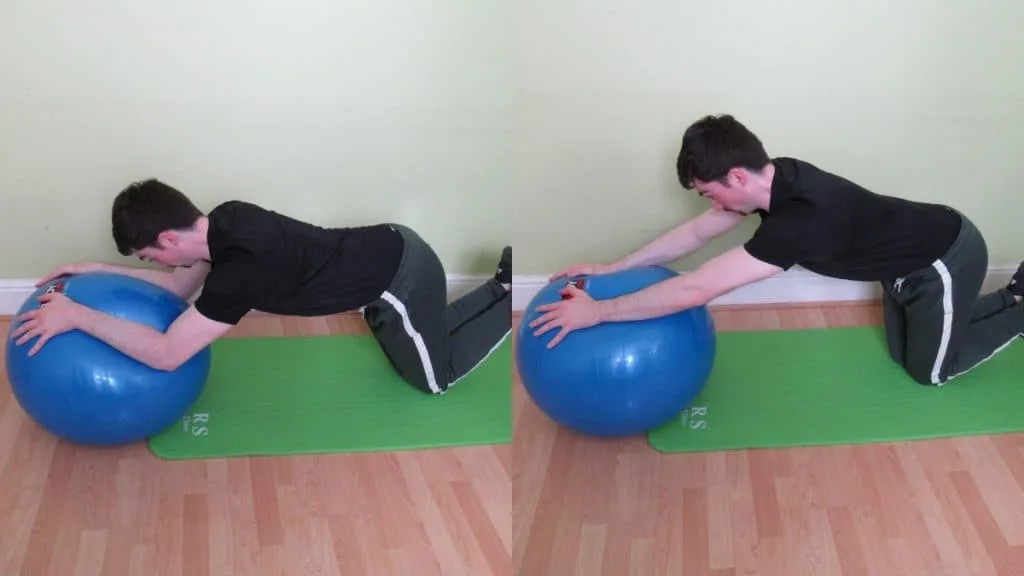
If you’re new to calisthenics or resistance training, then your best bet is to start by doing bodyweight tricep extensions on a stability ball.
Since the top of the ball, where you’ll be placing your forearms, is much higher up than the ground, you’ll naturally be using a lower percentage of your body weight. This makes the movement easier and more accessible, which is particularly useful if you haven’t yet built up the triceps strength to do a full body extension.
The key to getting the most out of this exercise is to keep the tension on your triceps by leaning into the movement while maintaining a neutral spine.
Don’t let your hips drift behind your knees when you push yourself up because this takes tension off the triceps.
Likewise, don’t let your upper back round forward because this will shift the emphasis onto your chest and shoulders, effectively turning your extension into a poorly performed push-up.
- Assume a tall kneeling position in front of a stability ball.
- Place your forearms palms-down on top of the ball and tighten your core.
- Bend forward at your waist slightly while maintaining neutral spinal alignment.
- Push through your hands until your forearms come up off the ball.
- Keep going until your elbows are fully locked out.
- Flex your triceps as you lock your elbows out
- Immediately lower your chest toward the ball by bending your elbows.
- Once your forearms press up against your biceps at the bottom of the rep, push through your hands again until your forearms come off the ball. Keep going until your elbows are extended.
- Perform 3-5 sets of 8-30 reps.
Kneeling bodyweight triceps extensions

If the stability ball version becomes too easy, then performing a kneeling bodyweight triceps extension on the floor is the next most challenging exercise.
The technique for this variation is exactly the same as it is for the full body version that you saw in the initial tutorial. The only difference is that you’re using a lower percentage of your body weight as resistance.
You can make the movement easier by using a wider hand position and, more importantly, by keeping your knees and feet in contact with the floor.
To make the exercise harder, use a closer hand position, lift your feet off the floor, and then lean forward more so that your lower legs come off the ground during the eccentric phase of the rep. As you push yourself back up, make sure the movement is occurring at the elbow joint. Some backward hip travel is okay, but you shouldn’t push your hips back to compensate for a lack of triceps exertion.
- Kneel on the floor with the undersides of your forearms on the ground and slightly in front of your shoulders.
- Ensure that your core is tight and that your spine is in a neutral alignment (don’t look forward, keep your head facing down).
- Push your hands into the floor to lift your forearms off the ground.
- Keep going until your elbows reach full extension. At this point, flex your triceps forcefully.
- Lower your torso back down to the ground in a controlled manner by bending at your elbows.
- Repeat steps 3 and 4 to complete your first full rep.
- Do 3-5 sets of 8-30 reps in total.
Bodyweight tricep extensions at home
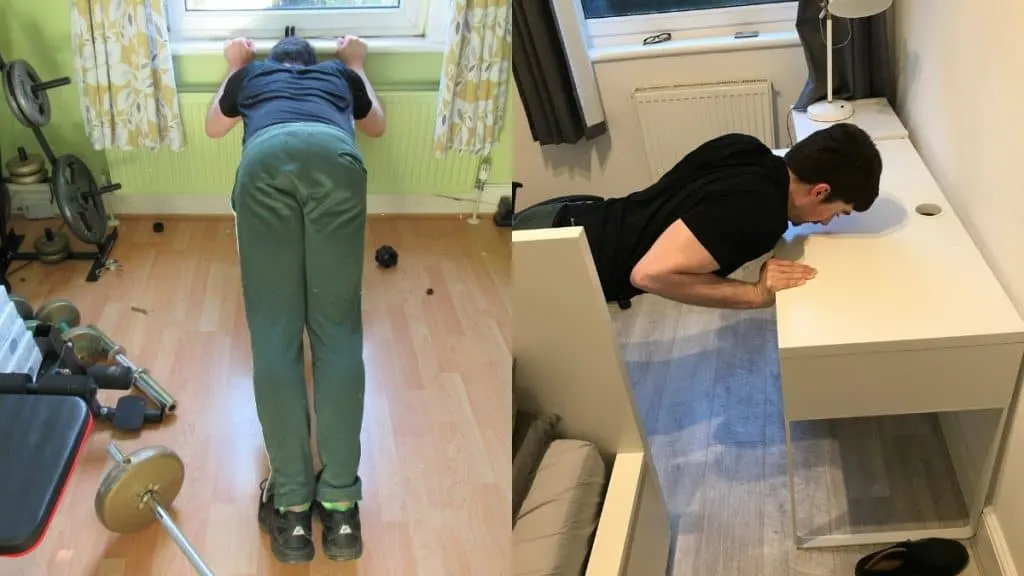
When it comes to performing body weight tricep extensions at home, the only limit besides your triceps strength is your imagination.
The only requirement is that you use a sturdy object or surface that can support your body weight.
Some good examples are a desk, bed frame, dining table, kitchen worktop, large piano, or sofa.
The lower the surface, the more challenging the exercise will be. The higher that your hands are, the easier the movement will be. So in most cases, doing a body tricep press on a sofa will be harder than doing a simple extension on your kitchen’s work surface.
- Place your hands on a stable surface or object.
- Shuffle your feet back and keep them around hip-width apart.
- Lower your face and chest toward the surface by bending your elbows.
- Once your biceps make forceful contact with your forearms at the bottom of the rep, flex your triceps to push yourself back up.
- Keep going until your arms are locked out.
- Perform 3-5 sets of 8-20 reps.
Body weight triceps extensions using a barbell
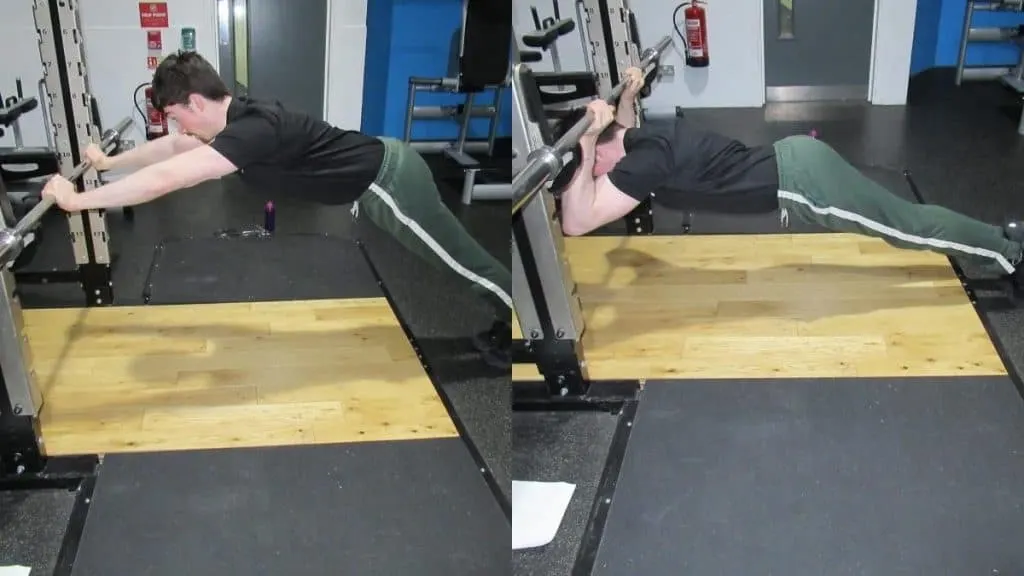
Performing a fixed bar tricep extension is preferable to doing bodyweight tricep extensions on the floor because the fixed bar tricep extension offers a more extensive range of motion.
You can also customize the resistance level by raising the bar to make the exercise easier or by lowering the bar to make the movement more taxing on your triceps.
Additionally, you can increase the range of motion further still by doing an underbar tricep extension where you lower your head underneath the barbell as opposed to just bringing your forehead to the bar. More on the under bar tricep extension in a minute.
For now, let’s stick with the slightly easier variation where you’ll be lowering your face to the bar. This exercise resembles a skull crusher and, as such, can be tough on your elbows if your joints aren’t used to handling a lot of torque.
You can sidestep much of the joint discomfort by using a higher barbell position, which means that you’ll be lifting a lower percentage of your body weight and thus putting less torque through your elbows.
- Place a bar in a squat rack at around waist height; lower down if you’re stronger and higher up if you’re a novice lifter.
- Place your hands on the bar just inside shoulder width.
- Shuffle your feet backward and lean your body weight into the bar.
- Lower your face toward the barbell in a controlled manner by “breaking” at your elbows.
- Keep going until you feel a strong stretch in your triceps (likely when your forearms press up against your biceps).
- Press yourself back up by flexing your triceps. Avoid pushing with your chest and shoulders.
- Lock your elbows out and flex your triceps forcefully at the top of the rep.
- Repeat for 3-5 sets of 8-20 reps.
Smith machine bodyweight triceps extension
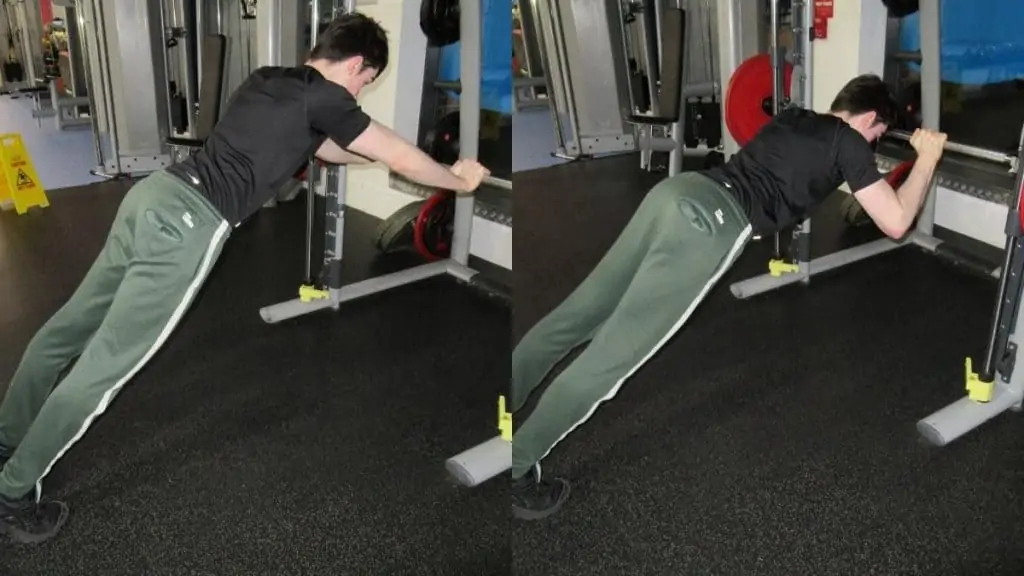
Performing a bodyweight tricep press on a Smith machine is very similar to doing a full body tricep extension in a squat rack.
The difference is that Smith machines typically have more bar height options than squat racks. This means that you can increase the difficulty dramatically by doing a vertical bodyweight tricep press with the bar in a really low position.
The Smith machine body weight tricep extension is also a very safe exercise if you make use of the bar stoppers. Specifically, you should rest the Smith machine bar directly on the safety stoppers so that you don’t accidentally rotate the bar off the hooks during your set.
- Place the Smith bar onto the safety catches.
- Grab the bar just inside shoulder width and shuffle your feet backward.
- Tighten your core, tuck your elbows in slightly, and keep your feet hip-width apart.
- Lower your face toward the bar by bending your elbows. You can also lower your head under the bar to increase the stretch on the long head of your triceps.
- Once you feel an intense stretch in your triceps, press yourself back up by pushing the palms of your hands into the bar.
- Squeeze your triceps as you lock your elbows out and repeat for 8-20 reps.
Full body tricep press
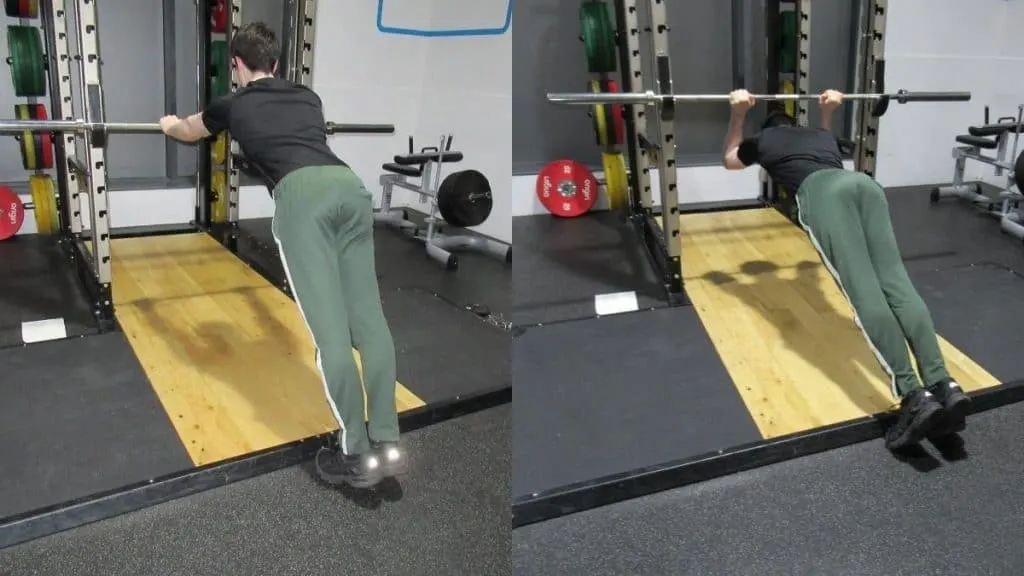
You can do the full body tricep press on a barbell, Smith machine, weight bench, or any other piece of equipment that allows you to lower your head underneath it.
The underbar tricep extension is the best calisthenics option that you have for hypertrophy because it places the biggest head of your triceps, the long head, under a deep, growth-stimulating stretch.
As good as diamond push-ups and dips are at building muscle, they simply don’t train the crucial long head to the extent that the underbar triceps extension does.
Although you can perform underbar tricep extensions on any piece of equipment that permits a full range of motion, I recommend using some kind of barbell to make the movement more customizable.
For example, if you’re not strong enough to do bodyweight tricep extensions with the bar in a low position but still want to train the long head of your triceps optimally, here’s what you can do: Simply increase the height of the bar in the rack, but rather than lowering your face directly to the bar, you’re going to lower your head underneath it.
This way, you make the exercise more manageable in terms of resistance, but you also make it more effective in terms of muscles worked.
- Position a bar in a squat rack or Smith machine at a height that’s appropriate for your strength level. This may take some initial experimentation.
- Grab the bar with a firm grip, just inside shoulder width.
- Move your feet back so that your knees are fully extended.
- Tighten your core and ensure that your feet are hip-width apart.
- Lower your head toward and then underneath the bar by bending your elbows.
- Once you feel an intense triceps stretch, press the palms of your hands into the bar and flex your triceps to push your body back up.
- Lock your elbows out and squeeze your triceps at the top of the rep.
- Perform 3-5 sets of 8-20 reps.
Bodyweight triceps extensions using a bench
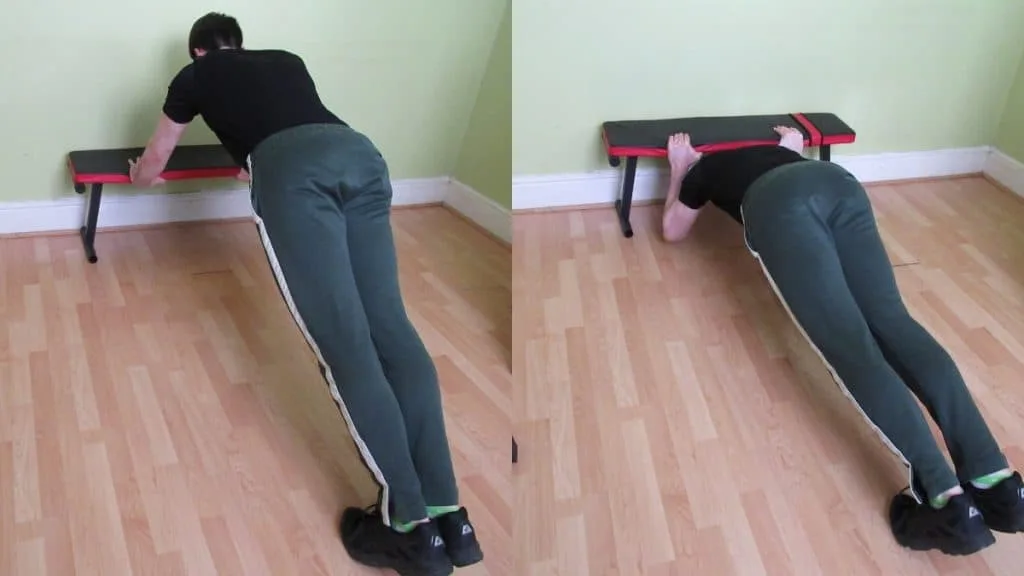
Performing a body weight triceps extension on a bench is highly challenging because weight benches are typically lower to the ground than any kind of bar in a squat rack. As such, your triceps are forced to lift a higher percentage of your body weight.
Again, you can either lower your face to the bench or bring your head slightly underneath it. The latter option is more challenging because it works your triceps over a larger range of motion, which naturally means that it also produces a more potent hypertrophic stimulus.
On the other hand, if both of these variations are too challenging, but all you have is a bench, then you can do a kneeling bodyweight tricep extension instead.
Just make sure that you’re using a commercial-grade bench for this one. You don’t want the bench to tip over under the strain of your body weight. So for maximum safety, use a sturdy bench and place it against the wall so that it can’t tip over.
- Place both hands on the long side of a weight bench at shoulder width.
- Move your feet back and keep them about hip-width apart.
- Bend your elbows and lower your head under the bench. You should feel an intense stretch in your triceps.
- Reverse the motion by pressing your hands into the bench and flexing your triceps in order to push your body back up.
- Keep going until your elbows are completely extended.
- Repeat for 3-5 sets of 8-15 reps.
Bodyweight triceps extension mistakes
Due to the absence of any free weights that need stabilizing, the bodyweight triceps extension might seem like a relatively simple exercise. And to a calisthenics pro, that certainly is the case.
However, many lifters—even those with good triceps development—hurt their joints and their progress by making these common bodyweight tricep press mistakes.
Excessive elbow flare
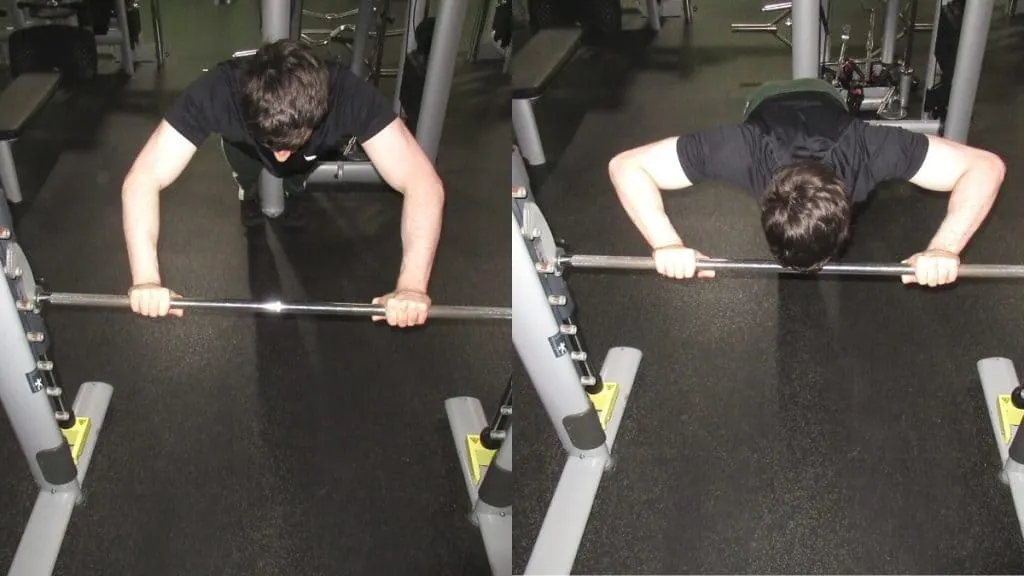
This mistake mainly applies to bodyweight triceps extensions performed on a bar. But the same thing can happen when you use rings or a stability ball.
Flaring your elbows out excessively recruits more of the muscle fibers in your chest and anterior deltoids, which effectively turns your extension into a press—and a poorly performed press at that.
Instead, you want to tuck your elbows in slightly once your hands are in position. You can think of this as “screwing” your arms into your sides or pressing your triceps into your lats, whichever cue works for you.
Keeping your elbows tight to your sides reduces the strain that gets placed on your shoulders while making the exercise even tougher on your triceps.
Unloading the triceps
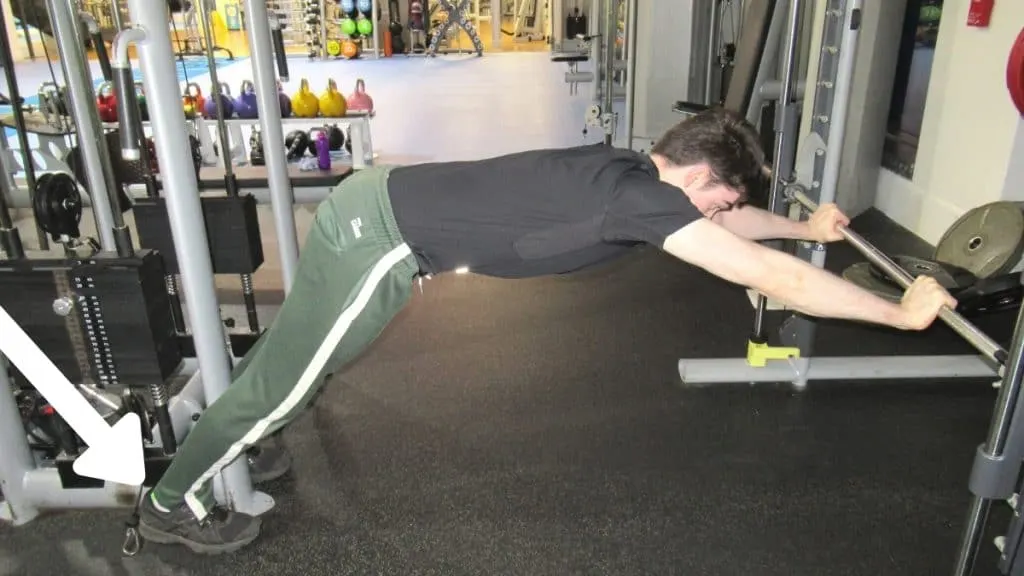
When many people perform the fixed bar tricep extension or any variation that resembles it, they often shift the weight onto their feet during the concentric phase of the rep to decrease the amount of work that their triceps have to do.
This unloads the triceps and makes the movement much less effective since the target muscles are receiving less tension.
Instead, increase the height of the bar and focus on perfecting your technique.
Rather than merely moving your body away from the bar, press the palms of your hands into the bar as if you were trying to push the barbell off your chest during a close grip bench press.
You can and should use your toes as a pivot, but you shouldn’t unload your triceps by allowing your heels to touch the floor.
Ultimately, keeping your abs and glutes tight while focusing on bending exclusively at your elbows will help you to avoid this common error.
Letting your hips sag
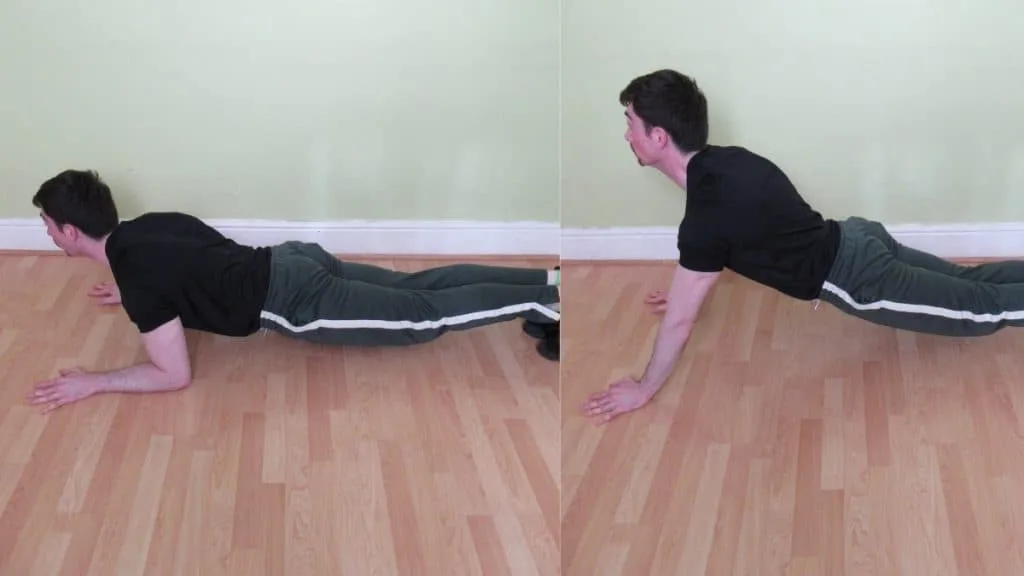
Letting your hips sag during a bodyweight triceps extension places more stress on your shoulders and causes your chest to come up, which turns the movement into a poor man’s push-up.
Additionally, because letting your hips sag moves your body further to the ground, it also causes your wrists to become unnaturally extended. This exaggerated extension skyrockets the amount of torque going through your wrist joints while simultaneously destroying your ability to produce force.
Gripping the bar tightly helps to activate your forearm muscles, which in turn encourages you to keep your wrists straight and out of harm’s way.
Like before, you can sidestep these problems by keeping your abs and glutes tight. It’s better to have your hips raised slightly than it is to let them sag. That said, you should aim to maintain a neutral spine where possible because this is the safest position for your back.
Bodyweight tricep extension sets and reps
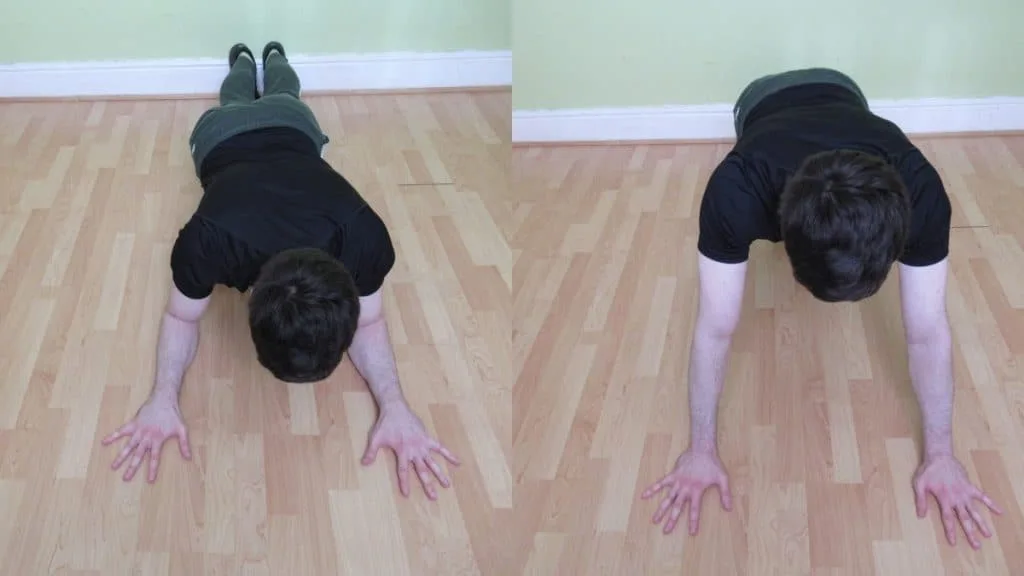
The bodyweight tricep extension is a versatile exercise that can be performed at any rep range. Most people, however, will get the best results from sticking to sets of 8-15 reps.
Going lower than 8 reps, especially if you’re also using more resistance, can put a lot of pressure on your elbows and cause them to become pained.
On the other end of the spectrum, sets of 20+ reps are actually a great way to finish off your triceps at the end of a workout. High rep sets are also the logical progression for calisthenics enthusiasts who can already bang out sets of 12-15 reps with ease.
The trade-off of pumping up your tris with high rep bodyweight tricep extensions is that you’ll be very fatigued because high rep training places a greater demand on your cardiovascular system than low rep lifting.
Conclusion: Should you do bodyweight tricep extensions?
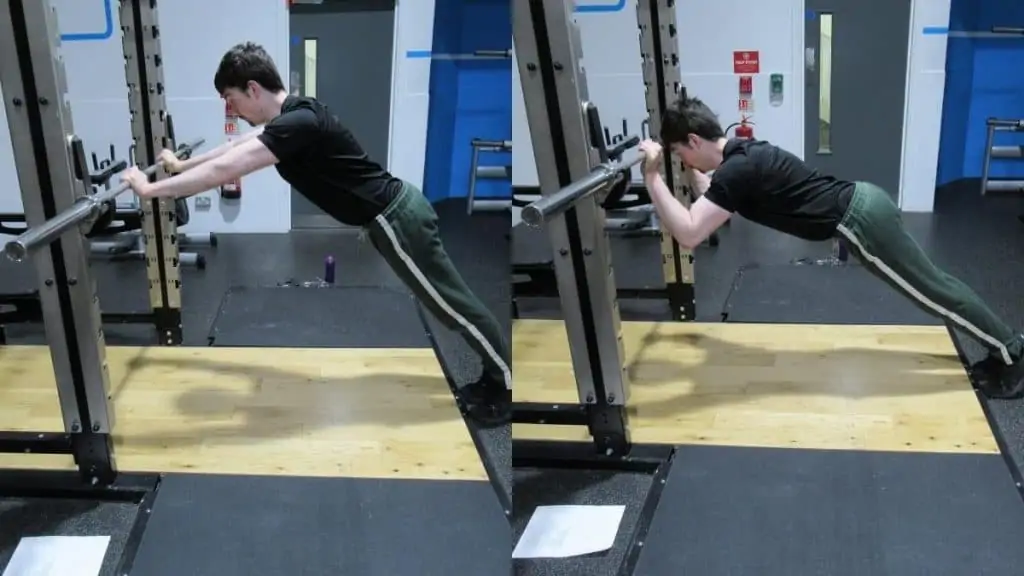
The bodyweight tricep extension is a highly underrated exercise for building muscle mass and developing bodyweight strength.
The movement is accessible to both bodyweight training beginners and advanced calisthenics athletes because the resistance is based on your body weight. Thus, the weight that you’re lifting is always relative.
Similarly, you can modify bodyweight triceps extensions to make them easier or more challenging. This can be as simple as slowing down your rep tempo in order to increase the time under tension. Or it could mean switching from the floor position to a barbell setup and then lowering your head under the bar to give your triceps a better eccentric stretch.
There really are a ton of customization options that you can take advantage of to elevate your tricep development to whatever level you desire.

